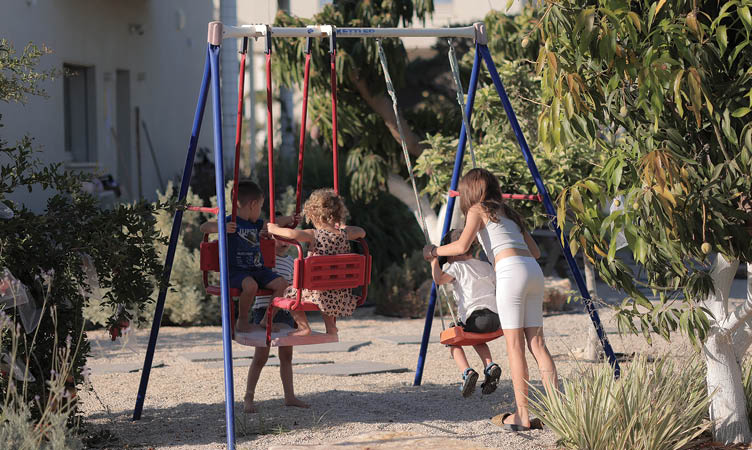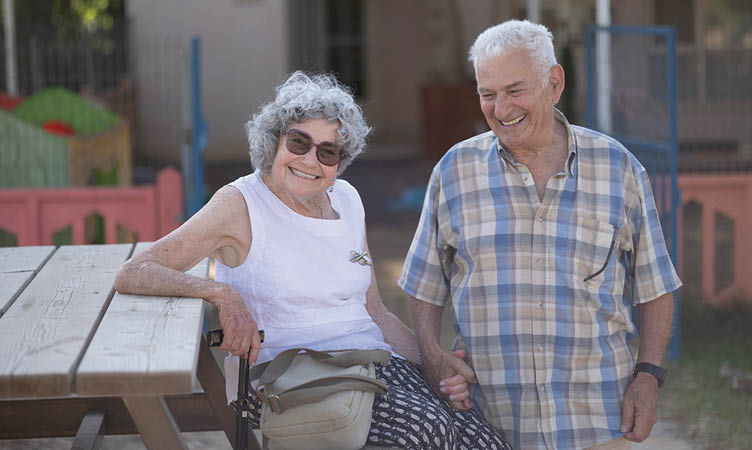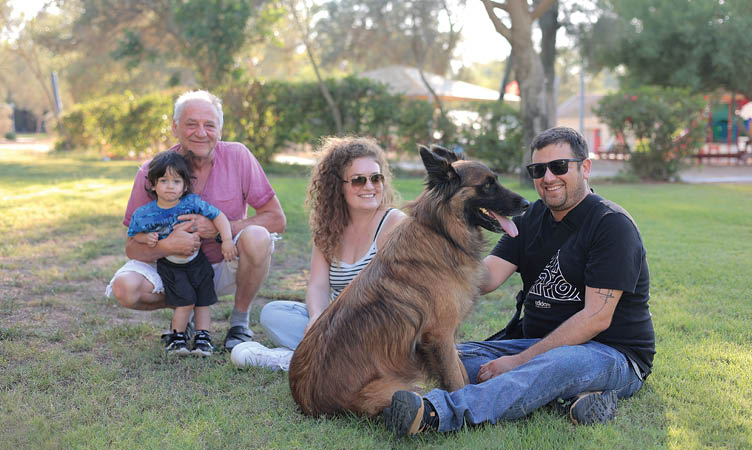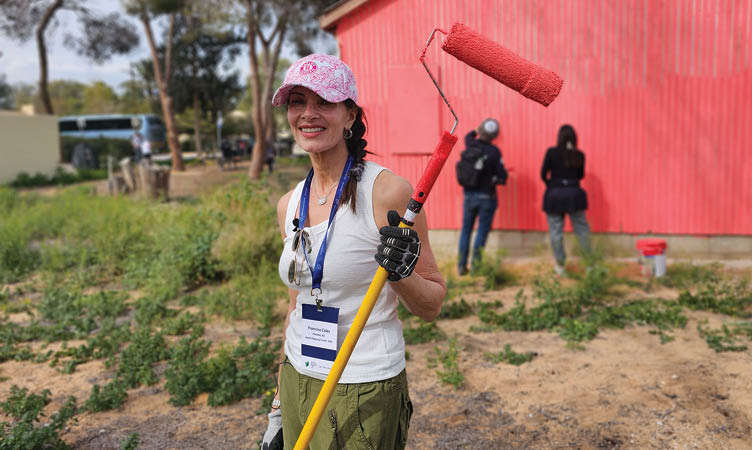“Life became a nightmare, and we didn’t know if we would ever come out of it. I remember getting a phone call from Jewish National Fund-USA asking me, ‘How can we support you?’ and I can’t begin to explain how much of a relief that was.”
Uttering these words, Maia Ifrach, the Head of International Relations and Partnerships for the Sha’ar HaNegev Regional Council, shakes her head almost in disbelief. That people half a world away were there for her community in such a profound way [following the October 7 attacks] still visibly affects her. Maia helps oversee 12 communities in the Israel Envelope on Gaza’s northeastern border. Eleven of them were evacuated; ten have returned. Her experience of going from shock and horror to hope and optimism is one that has played out across southern Israel thanks to Jewish National Fund-USA’s coordinated efforts across education, community building, counseling and mental health, social services, and security.
The foundation for this past year had been laid by Jewish National Fund-USA over the previous 15 years,” said Yoel Rosby, Projects Manager—Israel Operations for the organization. “We had a plan before October 7 which has enriched the lives of countless communities. Then October 7 hit, and our mission to help the people of Israel grew that much more. And now, we’re strategically looking toward the future in making the Israel Envelope an even more attractive place to live. So, we’re operating at all these levels – past, present, and future.”
The three major population centers bordering Gaza are the city of Sderot and two regional councils—Sha’ar HaNegev and Eshkol, which were hardest hit on October 7. Almost 100% of Sderot residents have returned, and they have even welcomed 1,000 new residents recently. Meanwhile, the regional councils continue to return their residents to the land. As of the fall, 80% of the Sha’ar HaNegev residents have returned, while an estimated 65% have returned to Eshkol.
At Kibbutz Re’im in Eshkol, the work progresses along with hope for a better tomorrow. To date, only 25% of the residents have returned, but as the work continues at a rapid yet careful pace, more are expected in the near future, according to Zohar Mizrachi, the secretary general of the kibbutz.
“In partnership with Jewish National Fund-USA we recently completed a new accessible and secure medical clinic,” she said. “Many have not come back specifically due to the lack of medical services, so this clinic is important and will help us bring back more of the community.”
A social worker by trade, Zohar has lived in Re’im for nearly 20 years and her husband, a local farmer, was born and raised there. “Jewish National Fund-USA helped us go from just surviving to dreaming of the future, from worrying about the here and now to planning what we want in the future. We are so grateful, really beyond words.”
“The first few days post-October 7 were some of the hardest of our lives,” Maia said, recalling the horrible time. “We had a long list of needs in those early days, and it was overwhelming,” she said. “Jewish National Fund-USA was our partner long before October 7 and they stepped up in a big way since that day.”
Zohar echoed Maia’s sentiment: “We felt so alone at first post-October 7, and disappointed with the government’s slow response. Jewish National Fund-USA and their partners were there for us—it’s been so heartwarming and calming.”
By partnering with local community leaders, the organization was able to immediately dive in and get to work. Even while supporting evacuated Israelis, volunteer mission participants worked to rebuild 21 communities, and 10 new parks. JNF-USA renovated a hydrotherapy center, created a brand new high school with 40 students, and is planning to soon start on 15 emergency response centers to strengthen civil security, a regional control and command center, and creating or refreshing dozens of community meeting spaces and clubhouses.
The crown jewel of the organization’s efforts to bring back a vibrant future to the region is a 32,000-square-foot community center in Eshkol, the largest project in southern Israel, which will house a 500-person amphitheater auditorium, a therapeutic hydrotherapy pool, a library, classrooms for the arts, music, physical fitness, and equipment for security needs.
“Every little thing matters,” Yoel emphasized. “We’re doing a lot, some big things, some small. And it all matters. Our most important asset is the children and the next generation, so we’re building and rebuilding with them in mind.”
Jewish National Fund-USA is also continuing work that had been in progress before October 7. One such project that had been planned before October 7, put on the back-burner, and is now returning to the forefront is the Sha’ar HaNegev Regional Sports Complex, which will be named after Ofir Libstein, the previous mayor of Sha’ar HaNegev who was murdered on October 7 by terrorists. The stadium will honor both his legacy and his dreams for the community’s growth and prosperity.
Safety is, of course, the most basic and fundamental need for any family choosing their home. To ensure the bright future that the people of Israel deserve, a necessary focus over the past year has been strengthening each community’s security infrastructure. Since October 7, three Emergency Response Centers (ERCs) were built in the Israel Envelope, in addition to a new sheltered emergency command center which serves as the regional council’s headquarters building.
“We started building ERCs with Jewish National Fund-USA before October 7, and we’re pushing full steam ahead,” said Elan Isaacson, Security Chief for the Eshkol region.
The ERCs serve the many volunteers from various emergency response services, including fire, medical, security, and civil emergency teams, providing easy access to equipment and operational needs in strategic locations.
“Each one brings security, community involvement, and a place to rely on. We are focused on giving our residents something to rely on,” said Isaacson.
All of this work and investment is only successful if it means a brighter tomorrow for Israel’s children, if it builds a Negev that truly blooms. A mother recalled how her family had recently moved back to Kibbutz Gvulot near the Gaza border. Her 3rd grader was apprehensive about going back to school and being away from her parents. The mother, after long months as an evacuee, understood that she couldn’t force the issue, so she suggested they just drive by on that first day and see how she felt. Her daughter agreed. When they arrived at the entranceway to the school the child saw the newly renovated campus with its verdant gardens, outdoor classrooms, sports fields, a barbeque area—when she saw all that, she perked up.
“This isn’t the scary place I left,” she said, then happily left her mom in the car and made her way to school. She was back in her home, rebuilt and rejuvenated, ready to move forward.
To learn more, contact Ashley Emrani at AEmrani@jnf.org or Assaf Grumberg at AGrumberg@jnf.org







